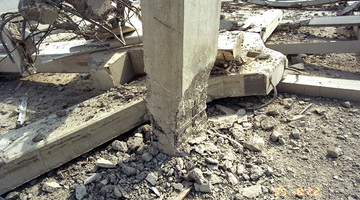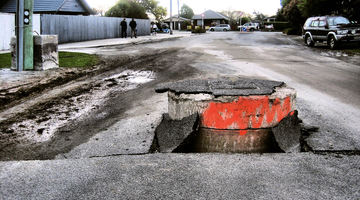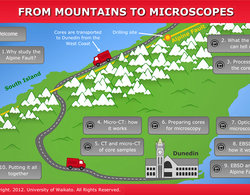

Shaky New Zealand About 14,000 earthquakes are recorded in and around New Zealand every year. Fortunately, most of them are too small for us to feel at the surface. However, many of us have felt ...
READ MORE

During tectonic plate movements, strain is placed on the land around us. The strained materials deform in one way or another as energy is released by earthquakes, faults and folds. These forces ...
READ MORE

In this activity, students take on the roles of seismologists, vulcanologists and geographers, using maps to look for patterns in the worldwide distribution of earthquakes, volcanoes and ...
READ MORE

In this activity, students use maps to plot a graph of earthquakes under New Zealand to show the shape of the North Island subduction zone and compare this to the distribution of earthquakes in ...
READ MORE

In this activity, students take on the roles of seismologists and vulcanologists, using maps to look for patterns in the worldwide distribution of earthquakes and volcanoes. By the end of this ...
READ MORE

Large snow events in most parts of New Zealand are uncommon. However, if you are in the South Island or the central North Island, this citizen science project could be a great one for your ...
READ MORE

Globe at Night is an international citizen science campaign to raise public awareness of the impact of light pollution by inviting citizen scientists to measure and submit their night sky ...
READ MORE

Litter is everywhere – but how much is there, and why does it matter? Litterati is an online citizen science (OCS) project that allows participants to photograph, upload and tag litter in their ...
READ MORE

About 14,000 earthquakes are recorded in and around Aotearoa New Zealand every year. Canterbury’s 7.1 and Kaikōura's 7.8 magnitude earthquakes and subsequent aftershocks show the constant threat ...
READ MORE

This online PD session, recorded on 18 February 2015, focuses on using Science Learning Hub earthquake resources to plan an Earth and Space science unit. It models how a variety of resources can ...
READ MORE

Children’s involvement in science is increased when they have an opportunity to make decisions about science-based issues that have consequences for their lives. It’s bringing science into the ...
READ MORE
Slow slips are silent earthquakes that occur below the Earth’s surface over a large area, unlike traditional earthquakes we feel that occur in a relatively small region. Before discovering slow ...
READ MORE
Chris Gannon and John Meyer from Robinson Seismic explain how the Ro-Glider works. Lead rubber bearings aren’t suitable for light structures, so Robinson Seismic has developed the Ro-Glider to ...
READ MORE
Far underneath the ground we walk on, the Earth is covered with tectonic plates. You can think of tectonic plates as puzzle pieces. Earthquakes and volcanoes often happen where the pieces meet. ...
READ MORE

In this interactive follow a core sample as it makes its journey from the Alpine Fault to microscopic examination. Click on the labels for more information. Select here to view the full ...
READ MORE

There are many different types of volcanoes around New Zealand. This interactive map shows where the major volcanoes are, the types of volcanoes and various facts such as when they last erupted ...
READ MORE

This interactive groups Hub resources into key science and technology concepts.
READ MORE